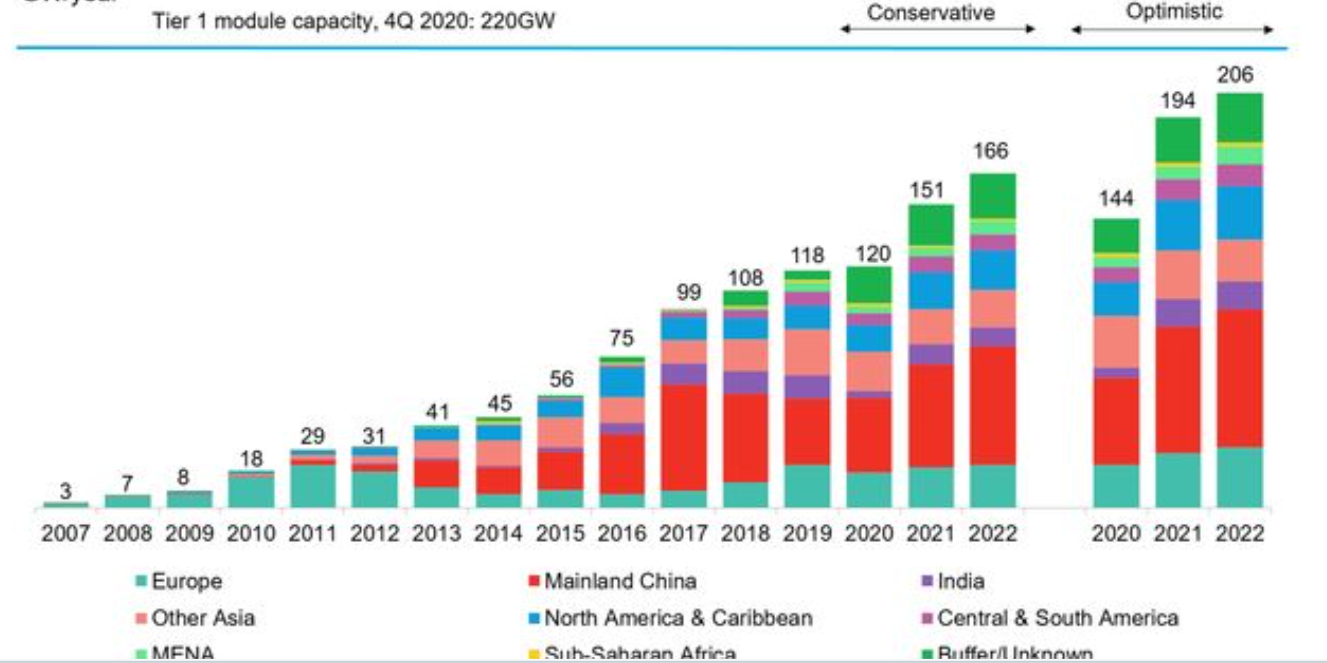The Clean Power Hour – a weekly clean energy headline review and commentary podcast run by Tim Montague, and yours truly – the CommercialSolarGuy – John Fitzgerald Weaver.
First of course, here’s the podcast – Episode 22.
Now, to the news!
At some point this will be a full-on story, but for now, it’s a blurb. In an interview, Elon Musk noted the Tesla battery manufacturing facility being built near Berlin could hit ‘100-200-250 GWh’ of capacity a year. That got me thinking about this research paper which suggested that 5.4 TWh of energy storage, or 12 hours of backup electricity, would allow the continental USA get to roughly 80% electricity from wind and solar. Some quick math later – 250 GWh/year into 5.4 TWh is 21.6 manufacturing years. So, three of factories could get us there ten years from today. Three years to build the facilities, work the bugs out and scale up the supply chains, and seven years to pump volume. We’re already building the first one in Texas.
The New Energy Giants are Renewable Companies (and the future is electric)
These four companies—Enel, Iberdrola, NextEra and Orsted—prioritized the building or buying of clean-power plants when those assets were still considered alternative and expensive. The tipping point may come next year, when Goldman Sachs Group Inc. projects that spending on renewable power will overtake that of oil and gas drilling for the first time. Source
W.A. mine becomes first to run on solar and battery only during daylight hours – plus to add onto this one with a bit more fun math. The article noted, ~14 million liters diesel saved over 25 years. That’s ~1,534 liters/day, and with AU$1.17/liter+delivery costs we’ve got $655k+/yr savings. A 1.2 MW solar project is AU$1.2 million, while the 350kWh battery might cost $200,000 – totaling $1.4 million. That’s about a two years payback.
Hybrid Systems – a subsidiary of Pacific Energy, which is in turn owned by the Queensland government-owned investment vehicle, QIC – obliged with a system that combines a 2MW diesel power station, 1.2MW of solar and a 350kWh Samsung lithium-ion battery, with an ABB inverter. Source
Solar power stations in space could be the answer to our energy needs
Researchers in China have designed a system called Omega, which they aim to have operational by 2050. This system should be capable of supplying 2GW of power into Earth’s grid at peak performance, which is a huge amount. Source
Btw, just published our first solar forecast with possible >200GW new build in 2022. The New Energy Outlook modelling we did earlier this year, including policy roughly as of 1H 2020 and then economic uptake, didn't do this until the 2030s.https://t.co/CW7Q8oC1Rg
— Jenny Chase (@solar_chase) November 25, 2020
As seen above, Jenny Chase at Bloomberg New Energy Finance and her team have put out numbers for 2021, and 2022 in their paid analysis. The 2022 optimistic numbers put solar over 200 GW – that’s a nice jump from today’s ~125 GW of capacity deployed. Also noted during Tim and I talking during the show is that there is a logic for the manufacturing capacity to be there, and for the countries around the world to be doing the building (China may pop to 75 GW+, along with Japan, India, the USA, and the EU all pushing volume growth as well).
Farms Will Harvest Food And The Sun, As Mass. Pioneers ‘Dual-Use’ Solar – Really waiting to see the next generations of truly agrovoltaic developed systems come online in Massachusetts. I’ve heard of these plants being developed by Bluewave Solar, and this article (Source) talks of it as well…tick tock tick tock.
Ambri Inks Agreement With TerraScale’s Energos Reno Project To Deploy Proprietary Liquid Metal Battery Technology – this feels very vapor’ish
“The collaboration is underway and includes delivery of 250 MWh of Ambri systems to TerraScale’s first project in Reno, Nevada starting in 2021.” Energos Reno is a 3,700 acre mixed-use development near Reno, Nevada that aims to enable secure, swift storage and transmission of data between government agencies and commercial clients. TerraScale intends to develop a data center with 500MW of renewable power on-site generation within ten years to power an inside-the-fence microgrid. Ambri’s batteries utilize a calcium || antimony based cell chemistry that began at MIT in the lab of Professor Donald Sadoway. Ambri’s investors include Bill Gates, Khosla Ventures and TOTAL SE. Source
Trina, Tongwei unveil major, multi-billion-dollar solar silicon, wafer and cell alliance
Trina signed the JV with two subsidiaries of Tongwei – YongXiang CO and Tongwei Solar – and the JV will collaborate on and jointly invest in facilities producing high-quality polysilicon, polysilicon rods, solar wafers and cells, with a total investment value of RMB15 billion (US$2.3 billion). Tongwei will take a 65% share in the projects and has provided an initial registered capital of RMB3.9 billion, while Trina solar will take a 35% share with a total registered capital of around RMB2.1 billion. Source
And now of course, the podcast –


